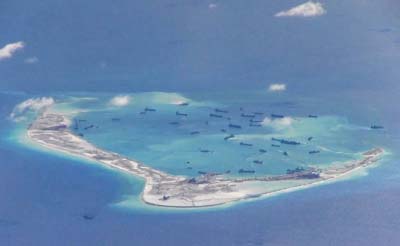
Reuters, Washington :
China has installed anti-ship cruise missiles and surface-to-air missile systems on three of its outposts in the South China Sea, US news network CNBC reported on Wednesday, citing sources with direct knowledge of US intelligence reports.
The move, if confirmed, would mark the first Chinese missile deployments in the Spratly Islands, where several Asian countries including Vietnam and Taiwan have rival claims.
China’s Defence Ministry did not immediately respond to a request for comment.
CNBC quoted unnamed sources as saying that according to US intelligence assessments, the missiles were moved to Fiery Cross Reef, Subi Reef and Mischief Reef within the past 30 days.
The US Defence Department, which opposes China’s installation of military facilities on outposts it has built up in the South China Sea, declined comment. “We don’t comment on matters of intelligence,” a spokesman said.
China has made no mention of any missile deployments but says its military facilities in the Spratlys are purely defensive, and that it can do what it likes on its own territory.
Greg Poling, a South China Sea expert at Washington’s Center for Strategic and International Studies think tank, said deploying missiles on the outposts would be important. “These would be the first missiles in the Spratlys, either surface to air, or anti-ship,” he said.
He added that such deployments were expected as China built missile shelters on the reefs last year and already deployed such missile systems on Woody Island further to the north.
Poling said it would be a major step on China’s road to dominating the South China Sea, a key global trade route.
“Before this, if you were one of the other claimants … you knew that China was monitoring your every move. Now you will know that you’re operating inside Chinese missile range. That’s a pretty strong, if implicit, threat,” he said.
CNBC said the YJ-12B anti-ship cruise missiles allowed China to strike vessels within 295 nautical miles. It said the HQ-9B long-range surface-to-air missiles could target aircraft, drones and cruise missiles within 160 nautical miles.
Last month, US Admiral Philip Davidson, nominated to head US Pacific Command, said China’s “forward operating bases” in the South China Sea appeared complete.
China has installed anti-ship cruise missiles and surface-to-air missile systems on three of its outposts in the South China Sea, US news network CNBC reported on Wednesday, citing sources with direct knowledge of US intelligence reports.
The move, if confirmed, would mark the first Chinese missile deployments in the Spratly Islands, where several Asian countries including Vietnam and Taiwan have rival claims.
China’s Defence Ministry did not immediately respond to a request for comment.
CNBC quoted unnamed sources as saying that according to US intelligence assessments, the missiles were moved to Fiery Cross Reef, Subi Reef and Mischief Reef within the past 30 days.
The US Defence Department, which opposes China’s installation of military facilities on outposts it has built up in the South China Sea, declined comment. “We don’t comment on matters of intelligence,” a spokesman said.
China has made no mention of any missile deployments but says its military facilities in the Spratlys are purely defensive, and that it can do what it likes on its own territory.
Greg Poling, a South China Sea expert at Washington’s Center for Strategic and International Studies think tank, said deploying missiles on the outposts would be important. “These would be the first missiles in the Spratlys, either surface to air, or anti-ship,” he said.
He added that such deployments were expected as China built missile shelters on the reefs last year and already deployed such missile systems on Woody Island further to the north.
Poling said it would be a major step on China’s road to dominating the South China Sea, a key global trade route.
“Before this, if you were one of the other claimants … you knew that China was monitoring your every move. Now you will know that you’re operating inside Chinese missile range. That’s a pretty strong, if implicit, threat,” he said.
CNBC said the YJ-12B anti-ship cruise missiles allowed China to strike vessels within 295 nautical miles. It said the HQ-9B long-range surface-to-air missiles could target aircraft, drones and cruise missiles within 160 nautical miles.
Last month, US Admiral Philip Davidson, nominated to head US Pacific Command, said China’s “forward operating bases” in the South China Sea appeared complete.

